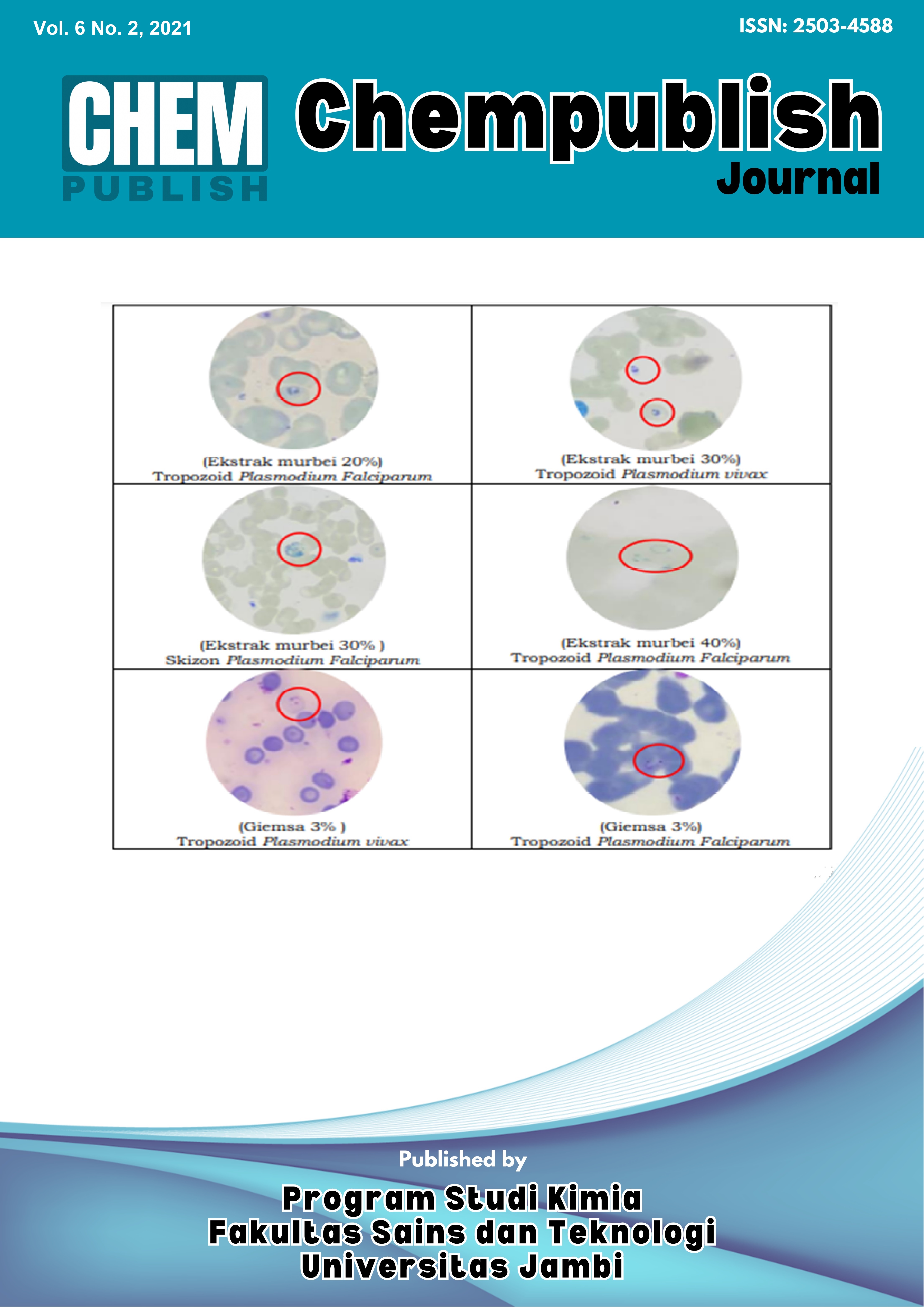Analisis Pembuatan Susu Kedelai dengan Gula Kulit Singkong (SKGKS) Terhadap Kadar Nutrisi dan Uji AKtivitas Anti Bakteri Coliform
Keywords:
SKGKS, soybean, cassava peelAbstract
Milk is one of the nutrients needed by the body. Milk can come from animal milk or vegetable milk. Soybean has a protein content equivalent to cow's milk which is about 3.5 g/100 g with a lower fat composition of 2.5 g/100 g. The sugar in the manufacture of vegetable milk is made from cassava peel waste. This research uses an enzymatic method that is able to hydrolyze starch in cassava peel. The resulting sugar is applied in the manufacture of low-fat soy milk that can be consumed by children to adults. The production of soy vegetable milk in this study was divided into two types of milk samples. The manufacture of soy milk begins with processing soybeans into soy juice. There are two types of soy milk in this study, type I is soy milk with a composition ratio between soybeans and water of 1:10, namely SKGKS I. While type II soy milk is soy milk with a composition ratio between soybeans and water of 1:35, namely SKGKS II. Both types of milk were analyzed for nutritional content and tested for anti-bacterial activity. The results showed that SKGKS 2 had a higher nutritional value than SKGKS 1. The nutritional content of SKGKS 2 was 11.56 g carbohydrates/mL milk and 2.93% milk protein. SKGKS II has a lower fat content than SKGKS 1, which is 1.23 g of fat/mL of milk. SKGKS types I and II showed a pH range of 6.74-7.12 with a storage time of 9 days. SKGKS II has a higher fiber content of 18.56 g with a food fiber content of 12.34 g. The results of the bacterial test showed that the two milk samples did not exceed the microbial contamination and were in accordance with the requirements of the Indonesian National Standard (SNI) No. 06.8-7388-2009.
Downloads
References
A, N. D. and Winardi, S. (2015) ‘PENDETEKSI SUSU BASI DENGAN SENSOR pH DAN SENSOR SUHU BERBASIS MIKROKONTROLER’, e-Jurnal Spirit Pro Patria, 1(1), pp. 47–53.
Amalia, N. R. P. and Aminah, S. (2021) ‘Kadar Serat , Aktivitas Antioksidan , Karakteristik Fisik Dan Sensoris Yoghurt Susu Kecambah Kedelai Dengan Penambahan Ekstrak Cincau Hijau’, Pangan dan Gizi, 11(01), pp. 50–59.
Anggono, W. A. and Wahyuni, R. (2017) ‘STUDI PENGARUH PENAMBAHAN KEDELAI (Glycine max L) DAN SUSU JAGUNG MANIS ( Zea mays L Saccharata ) TERHADAP MUTU DAN ORGANOLEPTIK ES KRIM’, Teknologi Pangan, 8(1), pp. 1–8.
Ariani, R. P., Ekayani, I. A. . H. and Masdarini, L. (2016) ‘Pemanfaatan Tepung Singkong Sebagai Substitusi Terigu Untuk Variasi Cake’, Jurnal Ilmu Sosial dan Humaniora, 5(1). doi: 10.23887/jish-undiksha.v5i1.8283.
Fauzi, A. R. and Puspitawati, M. D. (2018) ‘BUDIDAYA TANAMAN KEDELAI ( Glycine max L.) VARIETAS BURANGRANG PADA LAHAN KERING’, Jurnal Bioindustri, 1(1), pp. 1–9. doi: 10.31326/jbio.v1i1.89.
Ifmaily (2018) ‘Penetapan Kadar Pati Buah Sukun (artocarpus altilis L) dengan Metode Luff Schoorl’, Chempublish Journal, 3(1), pp. 1–10.
Kohli, D. et al. (2017) ‘Preservation and processing of soymilk: A review’, International Journal of Food Science and Nutrition, 2(6), pp. 66–70. Available at: www.foodsciencejournal.com.
Larasati, K., Patang and Lahming (2017) ‘ANALISIS KANDUNGAN KADAR SERAT DAN KARAKTERISTIK SOSIS TEMPE DENGAN FORTIFIKASI KARAGENAN SERTA PENGGUNAAN TEPUNG TERIGU SEBAGAI BAHAN PENGIKAT’, Pendidikan Teknologi Pertanian, 3(1), pp. 67–77.
Maris, I. and Radiansyah, M. R. (2021) ‘Review of Plant-Based Milk Utilization As a Substitute for Animal Milk’, Food Scientia : Journal of Food Science and Technology, 1(2), pp. 103–116. doi: 10.33830/fsj.v1i2.2064.2021.
Nabila, A., Puspitasari, C. E. and Erwinayanti, G. A. . S. (2020) ‘Penentuan Kualitas Madu Ditinjau dari Kadar Sukrosa dengan Metode Luff Schoorl’, Jurnal Sains dan Kesehatan, 3(1), pp. 242–247.
Nirmagustina, D. E. et al. (2013) ‘Pengaruh Jenis Kedelai dan Jumlah Air terhadap Sifat Fisik, Organoleptik dan Kimia Susu Kedelai’, Jurnal Teknologi Industri dan Hasil Pertanian, 18(2), pp. 168–174.
Niyibituronsa, M. et al. (2019) ‘The effect of different processing methods on nutrient and isoflavone content of soymilk obtained from six varieties of soybean grown in Rwanda’, Food Science and Nutrition, 7(2), pp. 457–464. doi: 10.1002/fsn3.812.
Pramesthi, R., Suprayogi, T. H. and Sudjatmogo (2015) ‘Total Bakteri dan pH Susu Segar Sapi Perah Fresian Holstein di Unit Pelaksana Teknis Daerah dan Pembibitan Ternak Unggul Mulyorejo Tengaran-Semarang’, Animal Agriculture, 4(1), pp. 69–74.
Putri, A. M. and Kurnia, P. (2018) ‘IDENTIFIKASI KEBERADAAN BAKTERI COLIFORM DAN TOTAL MIKROBA DALAM ES DUNG-DUNG DI SEKITAR KAMPUS’, Media Gizi Indonesia, 13(1), pp. 41–48. doi: 10.20473/mgi.v13i1.41.
Putri, I. and Priyono, B. (2022) ‘Analisis Bakteri Coliform pada Air Minum Isi Ulang di Kecamatan Gajahmungkur’, Life Science, 11(1), pp. 89–98.
Putri, S. W. A. and Hersoelistyorini, W. (2012) ‘KAJIAN KADAR PROTEIN, SERAT, HCN, DAN SIFAT ORGANOLEPTIK PROL TAPE SINGKONG DENGAN SUBSTITUSI TAPE KULIT SINGKONG Contents of Protein, Fiber, HCN, Organoleptic Properties at Cassava Tapae Cake with Substitution of Cassava Peel Tapae’, Jurnal Pangan dan Gizi, 3(6), pp. 17–28.
Reymon, Daud, N. S. and Alvianty, F. (2019) ‘Comparison Of Glucose Levels In Sweet Poultry (Ipomoea batatas Var Ayamurasaki) Using The Luff Schoorl Method’, Jurnal Warta Farmasi, 8(2), pp. 10–19. Available at: https://poltek-binahusada.e-journal.id/wartafarmasi.
Rohmah, E. A. and Saputro, B. (2016) ‘Analisis pertumbuhan tanaman kedelai (Glycine max L.) varietas grobogan pada kondisi cekaman genangan’, Jurnal Sains dan Seni ITS, 5(2), pp. 2337–3520.
Setyawati, R., Suriana, I. and Gafur, A. (2021) ‘Pengolahan Singkong Menjadi Produk Pangan Dalam Meningkatkan Kesejahteraan Kelompok Tani Bakti Karya Karang Joang Balikpapan’, Jurnal Karya Abdi, 5(1), pp. 102–108.
Tiska, F. B., Sustiyah, A. and Al-Baarri, A. N. (2015) ‘TOTAL BAKTERI ASAM LAKTAT, NILAI pH, DAN ADHESIVENESS SUSU BIFIDUS BERBAHAN BAKU SUSU DARI PETERNAKAN YANG BERBEDA DENGAN PENAMBAHAN EKSTRAK BUAH-BUAHAN LOKAL’, Teknologi Hasil Pertanian, VIII(1), pp. 56–62.
Tuhumury, H. C. D. (2015) ‘Effect of Soy Isoflavones on the Serum Lipid Profile and Vascular Function’, AGRITEKNO: Jurnal Teknologi Pertanian, 4(1), pp. 1–7. doi: 10.30598/jagritekno.2015.4.1.1.
Waliyansyah, R. R. (2020) ‘Identifikasi Jenis Biji Kedelai (Glycine Max L) Menggunakan Gray Level Coocurance Matrix (GLCM) dan K-Means Clustering’, Jurnal Teknologi Informasi dan Ilmu Komputer, 7(1), pp. 17–26. doi: 10.25126/jtiik202071066.






